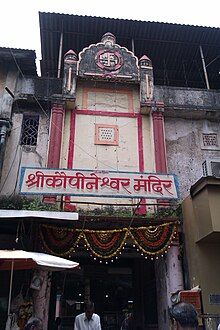Kopineshwar Mandir, Thane
This article needs additional citations for verification. (August 2015) |
| Shri Kopineshwar Temple (Thane) | |
|---|---|
 The main entrance of the Kopineshwar temple | |
| Religion | |
| Affiliation | Hinduism |
| District | Thane |
| Deity | Shiva |
| Location | |
| State | Maharashtra |
| Country | India |
| Geographic coordinates | 19°11′35″N 72°58′37″E / 19.193°N 72.977°E |
| Architecture | |
| Creator | Shilahara dynasty |
Kopineshwar Mandir (also Kaupīnēśvar Mandir) (Marathi: कौपिनेश्वर मंदिर) is a temple dedicated to the Hindu god Shiva and is considered the patron god of Thane. The Shivalinga inside the temple is considered one of the largest in Maharashtra, India.[1]
History
[edit]The temple was built by the Shilahara dynasty. It was renovated and rebuilt in 1760.[2] The hall in front of the garbha griha was rebuilt in 1879 by raising funds and donations. It was later again renovated in 1996.[1] The temple was earlier on the banks of the Masunda Lake(Talao Pali) but is currently separated by the Shivaji Road which reaches to the Thane railway station.[3] The temple has two entrances- one located opposite Masunda Lake and another inside the Jambhli Naka market.
Temple complex
[edit]The temple is located in the market area and at the entrance gates, is the Nandi (sacred bull). The principal deity temple of Shiva has a 12 feet diameter by 4'-3" feet tall Shiva Linga. The temple complex also houses shrines dedicated to Brahma, Rama, Hanuman, Shitala Devi (Thatakai), Uttareshwar (Kashi Viswalingeswar), Dattatreya, Garuda and Kali.[1]
References
[edit]- ^ a b c Gunde, Anupama (28 February 2014). "कौपिनेश्वर मंदिराचे होणार नूतनीकरण". Maharashtra Times (in Marathi). Retrieved 8 August 2015.
- ^ "प्राचीन श्रीस्थानक ते आधुनिक ठाणे शहर" (in Marathi). Thane Municipal Corporation. Retrieved 8 August 2015.
- ^ S. Kumar (2002). Journal of the Indian Institute of Architects, Volume 67. Indian Institute of Architects. Retrieved 8 August 2015.



